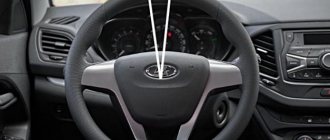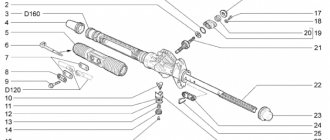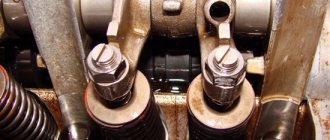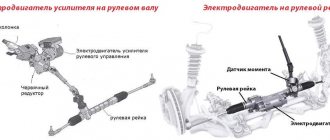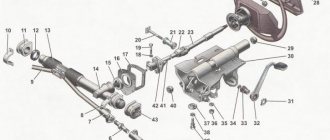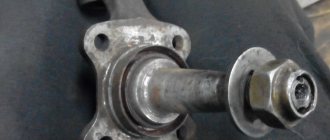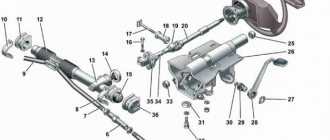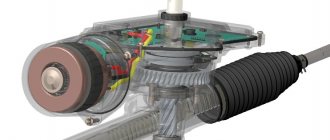It is difficult to imagine a modern car without power steering. After all, the ease of rotation of the steering wheel is one of the most important consumer parameters. Different manufacturers offer different amplifier options. How are they different from each other?
The first amplifiers were used commercially in the 1930s on trucks. At that time, the driver was already having difficulty coping with turning the wheels, despite the huge diameter of the steering wheel, and even the assistant driver (such a position existed then), in addition to the duties of car maintenance, was given a new duty - he helped turn the steering wheel in sharp turns. In fact, the car was controlled “with four hands.”
Power steering hydraulic system
It’s worth starting with this option, because it was the first to appear on cars and has still not lost its relevance.
Principle of operation
: Very simple, here the main working fluid is a special liquid, which is often poured into. The steering rack itself is a hollow cylinder into which a piston goes, attached to the steering shaft (to exaggerate it, it looks very much like a pharmaceutical syringe). A special pump pumps oil pressure in one direction or the other, and this piston begins to deviate in one direction or the other, accordingly helping you turn the steering wheel. There is approximately 0.5 - 1 liter of oil in the system, it is pumped by a pump that is driven by the engine crankshaft, that is, they are connected by a belt drive. Of course, the system contains metal and rubber tubes through which the working fluid actually pumps.
A few words about EGUR
. That's why electric power steering is now starting to appear. What does it mean? The differences are few, but they are significant - here, instead of a belt pump, an electric motor is used, that is, electricity is simply supplied and it pumps oil in the system. Thus, taking much less power and saving up to 0.5 - 0.7 liters per 100 km. Well, now it’s time to think about the pros and cons of this device
Pros of GUR
- Controllability. The driver has good feedback from the road; in terms of response accuracy and response, power steering comes first
- Great effort. Such amplifiers are installed on many HEAVY trucks; all electrical systems are not yet fully adapted
- Comfortable handling at both low and high speeds
- Now there are new generation devices with electric pumps that do not use a belt drive and save fuel
- There are no complex electronic sensors, we can call this system analog (except for power steering)
- Reliability is at a fairly high level, if you monitor it and change it on time, it can last a very long time
In general, there are not many complaints about this system; it still works stably, accurately and, importantly, can “turn” heavy truck racks. However, there are also a lot of negative aspects
Cons of GUR
- Takes up quite a lot of space under the hood (pipes, pump, rack itself) all this is quite cumbersome
- It has a special oil that needs to be changed after a certain number of kilometers, otherwise it may break down. Because oil seals can wear out faster
If the model is old (belt), it increases fuel consumption by up to 10% (if compared with the opponent). Because it additionally creates a load on the engine (pressure is built up thanks to a belt drive that comes from the crankshaft, respectively, part of the engine energy is spent on the hydraulic booster). Even at idle
- At low temperatures, you need to use it more carefully, it is advisable to warm it up
- If there is a leak or oil has leaked out, then you cannot operate the car! Or very limited mileage. Otherwise, the pump itself that pumps the oil may break.
- Repairs are sometimes very expensive. Although almost all service stations do this, there is nothing particularly complicated here
As you can see, the disadvantages of this system are also significant, especially power take-off and fuel consumption. After all, if you have a small-volume engine, it’s already “dead,” and then it also takes away the hydraulic booster.
Electrohydraulic amplifiers
Electro-hydraulic booster is a modernized hydraulic technology in which the pump is driven not by an engine, but by an electric motor. This allows you to significantly reduce fuel consumption, and savings can amount to about 1 liter of gasoline per 100 kilometers of vehicle mileage.
In such electro-hydraulic boosters, the pump does not operate constantly, but only when the steering wheel position changes. At the same time, the mechanical connection of the steering column and rack is preserved, which ensures high-quality feedback from the driver to the road.
Advantages of electro-hydraulic power steering:
1. Efficiency.
2. Fuel economy.
3. Accuracy.
4. Information content.
The disadvantage of the electro-hydraulic booster is the unreliability of the electrical equipment used, which leads to the need for frequent repairs, and the system itself is extremely critical to the quality of service.
What is the difference between power steering and electric power steering and which is better?
Now let’s compare these types of amplifiers with each other and try to determine which is better: hydraulics or electricity?
Let's start with the design features. The hydraulic booster is quite simple in structure, it is not afraid of malfunctions in the ECU. However, its anthers and hoses, as well as all kinds of seals, connections and other elements wear out relatively quickly. In addition, you need to monitor the fluid level in the power steering system. The electric amplifier is distinguished by greater durability and independence from consumables. Failures in the car’s electronic system can disrupt its operation, but they happen quite rarely. And if such a problem manifests itself, then problems with the EUR will probably be the least of the problems. Both types of mechanisms have an emergency mode of use.
Let's move on to ease of use. As practice shows, hydraulic boosters of even the simplest designs are more informative than electronic systems. They provide better connection with the road surface and make it possible to experience the maximum capabilities of the car when taking sharp turns. The EUR is theoretically also capable of this, but for this it must be carefully calibrated, which is done only on premium cars. In general, the hydraulic booster provides a highly informative and natural driving experience - however, it requires more physical strength than the electrical system.
Next, we will consider amplifiers from the point of view of efficiency and reliability. During operation, power steering consumes the power of the car's engine, which is why its appetite increases and its dynamic characteristics deteriorate. In addition, it is sensitive to high loads: it is not recommended to hold the steering wheel in extreme positions for more than 15 seconds, otherwise the pump may fail. The electric booster is driven by its own motor. Under increased loads, it can also overheat, but the automation in this case will reduce its performance or turn it off until the temperature drops.
The scope of application of the power steering is higher; it can be used both on a city minicar and on a multi-ton truck. The EUR is much weaker and therefore suitable only for passenger cars (and even then not for all).
Therefore, it is impossible to give a clear answer to the question of which is better power steering or electric steering. The latter was developed as a replacement for the hydraulic system, devoid of its inherent disadvantages, so for a number of factors it is definitely better. At the same time, power steering has a significantly wider scope of application and at the same time a lower price. Therefore, preference should be given to one option or another solely taking into account personal preferences and the characteristics of the desired car.
Types of steering
The most common classification is based on the type of gearbox installed on the car:
1. Rack and pinion .
Popular with passenger cars with independent suspension. It impresses the vehicle owner with its high efficiency, low price, small dimensions, simple design (the steering wheel itself + the steering rack that drives the rack, middle and side links, and the tip). Moreover, if you are driving on an uneven road, it is easy to “mint” impacts directly on the steering wheel. Among the common malfunctions is the appearance of knocking noises in the rack. The problem is partially (but not completely) solved in rack-and-pinion models with dampers mounted between the steering rack housings and the rods. Thus, it is possible to dampen vibrations. The steering wheel can be strengthened mechanically (in old cars) or using hydraulics and electronics (relevant for modern vehicles).
2. Worm.
The design combines a shaft, bipod (lever), and crankcase. There is a roller attached to the bipod. A worm is mounted in the lower area of the shaft. The worm-roller pair is always in mesh. When the driver turns the steering wheel, the roller begins to move along the teeth of the worm, at this moment the bipod shaft also turns. Translational motion is transmitted to the wheels and drive. Cars equipped with worm gears are maneuverable and there are no problems when driving on bad roads. Most often, this solution is found in old trucks, buses, and also in a number of passenger cars with dependent suspension. Since the control unit has a large number of connections, periodic adjustment is required. This is not very convenient. At the same time, speech is not cheap, it is so difficult to produce.
3. Screw.
In fact, this is a more advanced version of the worm. There is also a rail here. But to start the mechanism, well-functioning “screw-nut” teamwork is required. There are balls in the thread. Therefore, physically, instead of friction, when the mechanism is started, rolling begins. When changing direction, the screw moves the nut, the rack deflects the sector, and the bipod and steering rods also deflect.
SRUs with a “screw-ball nut” type mechanism have long been mounted mainly on luxury cars, as well as buses and trucks. But modern manufacturers have significantly expanded the range of applications of such a mechanism. It is functional, convenient and at the same time unpretentious in maintenance.
Depending on the tasks being solved, the steering of a car or truck can be:
- Active (AFS or Active Front Steering) and dynamic. The solution allows you to take into account the current speed, turning angle on a slippery road and adjust the gear ratio depending on them. In AFS, adjustment is carried out using a planetary gearbox, in dynamic control gear - through wave transmission. Dynamic RC is easy to find on Audi, active RC on BMW.
- Adaptive (DAS or Direct Adaptive Steering). The solution makes it easy to maneuver at low speeds (very valuable when the driver is parking), and at higher speeds to drive smoothly, without feeling a rigid connection between the car’s steering wheel and its wheels. The SRU actually adapts to individual requests and traffic conditions. Wheel force sensors and a steering angle sensor help achieve the result. The system is actively installed on Infiniti.
- Servotwin. Integrated electro-hydraulic solution. Designed for targeted steering of the rear axle. Focused on improving maneuvering of heavy vehicles (trucks, buses with a wide wheelbase). The torque of the control unit is adjusted to the speed of the vehicle, and in case of sudden gusts of wind, the position of the steering wheel is adjusted. The developer of the solution is Bosch. At the same time, it is adaptable for vehicles from different manufacturers. Including, it is possible to modernize previously produced buses and trucks. Servotwin has lane assist. This assistant protects you from the risk of deviating from your lane, and in slow traffic with such a steering system it is easy to maintain a safe distance from the vehicle in front.
Sometimes Servotwin is also called adaptive SRU. But still, more often than not, when they simply talk about adaptive steering, they mean the popular DAS solution for passenger cars, and Servotwin for commercial vehicles is placed in a separate category.
Electric power steering operating principle
The working fluid fills the reservoir and then goes to the power steering pump through the connecting hose. When you turn the steering wheel, the control unit supplies power to the electric motor, which turns on and begins to rotate the power steering pump shaft at a frequency depending on the vehicle speed and the force applied to the steering wheel. Power is also supplied to the corresponding solenoid valve, depending on the direction of rotation. The pump creates fluid pressure and transfers it through the corresponding valve to the hydraulic cylinder. The hydraulic cylinder, using the energy of the working fluid, generates a force proportional to the pressure of the fluid, which moves the piston and rod, then they turn the wheels in the desired way using a system of levers.
Power steering
Perhaps the most common type of power steering mechanism is the hydraulic booster (power steering). An additional unit is installed on the car engine - a power steering pump. This pump creates special oil pressure, through which elements move in the rack. When the steering wheel is stationary, oil is pumped freely around the steering rack. As soon as you turn the steering wheel a little, oil under pressure enters the corresponding part of the mechanism. The wheels turn, the distribution mechanism returns to its original position, and the oil again begins to bypass the rack.
The main power steering malfunction is oil leakage through the seals and hose joints, as well as a malfunction of the pump itself. Usually the pump fails after running dry. Thus, from one fault follows another. To avoid this, check the oil level periodically.
Benefits of driving with power steering
- the amplifier takes the lion's share of the load onto itself;
- there is no need for a large number of turns of the steering wheel, it does not break out of your hands;
- the feeling of road unevenness is softened;
- the machine is easier to control, maneuverability increases; difficult turns can be made without effort;
- taxiing at low speeds becomes more convenient;
- the trajectory of movement is stabilized;
- if the front tire is punctured, it is easier to hold the car;
- the driver is less stressed and does not get tired;
- This is especially true if the driver is a woman;
- The wear resistance of the steering mechanism increases and its service life is extended.
All this ensures the most safe and comfortable driving (provided the car is in good technical condition).
A potential danger arises only in an emergency situation - a sudden failure (breakdown) of the power steering system when turning while driving. In this case, the reaction, knowledge and experience of the driver become crucial. Problems can be signaled by extraneous noises, vibrations, sharp jolts, turning the steering wheel, turning it difficult or too easy.
According to statistics, a quarter of Russian drivers prefer power steering, and half prefer electric power steering (and the indicators are biased in favor of electric power steering). The advantages of each of these mechanisms are determined by their design features.
Modern cars use electric power steering, hydraulic power steering and electric power steering.
Adjustment
In order to increase driving safety and reduce the load on the driver’s arms and back, the vehicle’s steering mechanisms require adjustment.
Adjustment can be mechanical or electronic. Most often, the tilt of the steering wheel is adjusted. The adjustment allows the driver to achieve the most ergonomic and comfortable position.
The most popular option is a mechanical steering wheel angle adjustment mechanism with a lower hinge. It consists of stoppers, bracket and locking bolt.
The stoppers turn. When the lever is in the locked position, the protrusions of the stoppers are opposite each other, an axial force arises, and the column bracket is fixed. When the lever is in the unlocked position, the protrusions of one of the stoppers are in a position exactly opposite the depressions of the other stopper.
The mechanical mechanism for adjusting the height of the steering wheel is also very popular. Adjustment is carried out due to the joint work of the sliding shaft, locking bolt, and locking wedges.
The locking wedges change position when the lever is turned. When the lever is locked, locking wedges secure the sliding shaft in the desired position. When the lever is unlocked, free space appears between the sliding shaft and the locking wedges, creating ideal conditions for moving the shaft along the axis.
As for electrical adjustment, the most advantageous option is combined solutions for simultaneous adjustment of the angle of inclination and height using a servo drive.
For the driver, adjustment is very simple. You just need to press the “Up” and “Down” keys. Therefore, although the solution is not the cheapest, it is very popular.
Pros and cons of EUR
The advantages of EUR are the following nuances:
- it does not require the power of a car engine to operate;
- fuel is saved to a certain extent;
- the electronic mechanism is quite compact;
- the system does not use liquids, so operation is simplified;
- the EUR design does not contain damage-sensitive hoses, boots, etc.;
- The steering system, equipped with an electric booster, always works clearly, without losing the sharpness of its response.
The disadvantages of electric power steering include the following:
- high price - EUR is significantly more expensive than power steering;
- the complexity and high cost of repairs, although the service life of such units is quite large;
- low power, which is why heavy jeeps, trucks and other heavy vehicles are not equipped with electric boosters.
Efficiency and reliability
Using power steering forces the car to lose some of its power - it goes to drive the pump, which can have quite large needs. Therefore, the use of power steering inevitably leads to a deterioration in dynamic parameters and a significant increase in fuel consumption with other comparable parameters. Moreover, even with constant movement in a straight line, the situation does not improve at all - the pump works constantly, moving oil through the high and low pressure pipes.
Every motorist should know that the hydraulic booster cannot withstand operation in extreme conditions for a long time - if the steering wheel is held in the extreme position for 10-15 seconds, the pump will overheat, as a result of which the unit will completely shut down. To restart it, you need to turn off the car, wait a few minutes and start it again, carefully moving the steering wheel from the extreme position to the zero point.
Electric boosters are considered more economical - they do not take engine power directly, but only create additional load on the generator. In addition, the electric booster only works when the wheels are turning, and when moving along a straight path, the motor remains completely switched off - it does not worsen the dynamic characteristics of the car and does not create additional ones. Also, when turning the steering wheel to its extreme position, heating will occur only when the steering wheel is rotated very quickly in different directions, which can only be done on purpose.
However, turning off the electric boosters cannot be called a rarity - this mainly happens when driving off-road or on roads covered with viscous, loose snow. After some time, the unit will give an alarm, after which its performance will be limited and the driver will see a warning, and if driving continues under similar conditions, the amplifier will turn off until the motor has completely cooled.
EPS malfunction
EPS malfunction pictogram
If the warning lamp on the instrument panel (an icon with a steering wheel with an exclamation mark) lights up, this indicates an EPS malfunction. The appearance of an error indicates that the electric amplifier does not undergo self-diagnosis when the ignition is turned on. The cause of the malfunction can be many factors, for example, the failure of any of the sensors included in the EPS control system. Although you can drive a car without an electric booster, you should not do this. It's better to turn to specialists.
Advantages of electric power steering
- Ease of steering with electric steering (“one finger”). Excellent maneuverability when parking, quick adaptation to changes in speed.
- Settings of power steering parameters for various operating modes. (Crosswind stabilization, car parking)
- Width of temperature range for EUR. The fluid in the power steering can freeze and boil under the influence of temperatures and overloads.
- Simplicity of design and maintenance of the EUR. You just need to monitor the condition of the bearings. Power steering maintenance is more labor-intensive. Regular inspection is required for integrity, monitoring the tightness of hydraulic tubes, checking the tension of the drive belt, and the oil level. There are rules for changing the oil and filter.
- Compact dimensions of the EUR.
- Economical efficiency of electric power steering (less fuel consumption, higher efficiency).
- Operation of the machine after disconnecting the faulty power steering. This is undesirable for power steering (the steering is destroyed; other breakdowns may occur).
- The ability to hold the steering wheel in the extreme position for a long time with ESD. On cars with power steering, a delay of more than 5 seconds threatens serious damage.
- Environmental friendliness of the EUR. Cars with power steering produce more harmful emissions; power steering units that have expired are more difficult to dispose of.
- Serious prospects for progress of ESD.
Pros and cons of power steering
The undoubted advantages of hydraulic boosters include the following:
- adaptability to high loads, which allows the use of power steering on heavy vehicles, including trucks;
- relative cheapness, which also affects the overall cost of the car;
- ease of machine control over a wide speed range;
- relative ease of maintenance and availability of repairs;
Power steering also has its disadvantages:
- engine power is used to operate the pump;
- the seals are easily damaged, as a result of which the system begins to leak;
- the efficiency of the hydraulic booster directly depends on the level of fluid in its reservoir;
- the fluid needs to be changed periodically;
- Power steering does not make it possible to individually adjust the performance characteristics of the steering system.
Electric power steering or EPS
EPS is an electric power steering in which the force necessary to turn the wheels is created by an electric motor. A peculiarity of systems of this type is that they are mounted directly on the steering rack or column. For comparison: power steering is often installed as a separate system.
The main structural elements of the EUR are:
- electric motor;
- torsion bar;
- steering shaft;
- gearbox;
- steering position and angle sensor;
- torque sensor;
- Control block;
- toothed gears.
When the driver turns the steering wheel, the torsion bar twists. The torque created in this case is recorded by a corresponding sensor, in which the received information is interpreted into a signal supplied to the electronic control unit. Here, this data is analyzed and compared with information transmitted from other sensors, including the speedometer, tachometer, etc. Based on the results of the analysis, the ECU determines the force required to turn the steering wheel and sends a command to the electric motor. As it rotates, it transmits its rotation to the steering shaft or directly to the steering rack.
Hydraulic power steering
Therefore, in the middle of the century, air was replaced by liquid. Hydraulic boosters do not have the disadvantages of their predecessor. The engine-driven pump creates the required pressure. A distributor connected to the steering shaft monitors the angle of rotation of the steering wheel and the resistance on it, dosing the amount of oil sent to an additional device, which turns the wheels. It can stand separately from the steering mechanism or be integral with it. In the latter case, the hydraulic booster is called integral. It is mainly used on passenger cars - from Lada to Mercedes.
The hydraulic booster also smoothes out shocks from road unevenness that come to the steering wheel. At the same time, “hydraulics” are so effective that they allow you to keep the car on the road, even if a tire suddenly bursts and the resistance on the steering wheel increases dramatically. Maneuverability improves - you have to turn the steering wheel less from lock to lock.
The disadvantages of the hydraulic booster stem from its complexity. It is necessary to monitor the fluid level, monitor the tightness of the lines, change the oil, etc. The power steering pump runs constantly, regardless of whether the driver turns the steering wheel or not. This means that the engine wastes no less than 7% of its power (for a city minicar this is a significant figure). The pressure in the system directly depends on the crankshaft speed. Therefore, when maneuvering at low speeds or when the steering wheel rotates quickly, the pump’s performance is not enough. The steering wheel, as they say, “snacks.” And on the highway, on the contrary, it becomes “empty”, the “feeling of the road” is lost - after all, at high engine speeds, the amplifier works to the maximum; to solve this problem, special devices are used (pump with variable capacity, various valves, modulators, etc.). ), complicating and increasing the cost of an already complex mechanism. In addition, the entire system is very heavy. This is not important for the buyer, but the designer, in order to maintain the specified parameters of the car (lifetime, maximum speed, etc.), is forced to increase engine power and strengthen other elements, which in turn increases the cost of the car.
Comparative characteristics
Disadvantages of electric power steering and advantages of power steering:
- There is sensitivity of the EUR to bad (sloppy, bumpy) roads and moisture (in particular, in bad weather - when there is snow, rain, puddles). In such cases, there is a danger of overheating and shutdown, as well as burnout.
- The power steering better smooths out shocks when the road is uneven and when hitting a curb.
- The EUR does not provide an immediate response if the wheels quickly turn in the other direction. And if you twist the steering wheel sharply, the system may turn off altogether.
- There are more possibilities for self-repair for power steering.
- In the case of electric power steering, the possibility of electronic failure cannot be ruled out (however, this mainly occurs in old and cheap models; another reason is non-compliance with operating rules).
- Production of power steering is less expensive; their price is lower than that of the EUR.
- The EUR is limited for installation on heavy trucks and SUVs (due to lack of power).
EUR
EUR with a worm drive built into the steering rack is easy to distinguish by appearance.
The electric motor is attached to its body next to the input shaft. EUR with a worm drive built into the steering rack is easy to distinguish by appearance. The electric motor is attached to its body next to the input shaft.
This view reveals a group of full electrical rails with built-in amplifier elements. In fact, such an electric power steering system has the same negative features when driving as in the previous example. The magnitude of parasitic friction losses and moments of inertia are similar.
During operation, the severity of malfunctions and the cost of repairs increases due to the fact that all elements of the amplifier are built into the rail.
EUR electric power steering
It was created as a more advanced and simpler system (and is still being improved). It has a lot of varieties, at least read it.
Principle of operation
: Again, in a nutshell - everything is simply taken by an electric motor, connected to a shaft (on which there are special grooves, or a screw, or just splines) and this electric motor pushes this shaft to the right or left.
The only difference between electric amplifiers is that the electric motor can be attached to different parts of the steering mechanism:
- On the steering column
- On the rack shaft itself (I use a spline connection)
- Parallel to the steering column shaft (twin shaft systems)
- Using a ball nut
Ask why there are so many different mechanisms - it’s all because you haven’t yet achieved the normal effort and accuracy of “steering” like your opponent. Although the last type with a ball nut came very close to this.
Of course, the EURA has no liquid, no hoses and tubes, no pump - it is very compact, which often allows it to be mounted even on the steering column.
However, the negative side here is the presence of various sensors and other electronics, but everything is in order
Positive aspects of the electric booster
- The driver has sufficient effort and contact with the road
- Has two positions. City and highway. In city mode, the steering wheel is lighter, which contributes to comfortable driving. In the “road” mode, it turns off already at 40–60 km/h, which was done on purpose; at high speeds, an amplifier is not needed. Therefore the feedback is increased.
- Fuel economy. There is no additional load on the engine because it has no belt drives and is powered by electricity from a generator (battery). If the car is stationary and the steering wheel does not turn, it does not work. Activated only when turning. Allows you to save up to 10% fuel
- It takes up little space under the hood and in the cabin. Since it is technically simpler (and more compact) than power steering
- It has no liquid and, accordingly, is practically maintenance-free
- Has a wide temperature range of use. For example, in winter there is no need to heat it. Even a few seconds
- If it breaks, you can move freely, but the steering wheel will become heavier, at least you will always get to the service station
- Many electronic autopilot (autoparking) systems work only with electric power steering
- AT THE MOMENT - RELIABLE, not inferior in quality to the hydraulic booster
As you can see, there are really a lot of positive aspects, some of them don’t even know that they have an electric booster until it reaches 150 – 200,000 km, because there are simply no cans or other parts under the hood. I like that lately it has been tuned quite precisely, that is, it is beginning to be similar in “steering” accuracy to its opponent. However, it is still far from it, yet there are also a lot of disadvantages here
Negative points of EURA
Repairs are expensive and difficult to diagnose. Ordinary service stations often simply do not know what is broken, there are simply oxides on the contacts and such an amplifier is already faulty. You need special diagnostic tools to read errors. Also, the blocks here are often not repaired, but replaced as an assembly. If the engine is damaged, it is often cast with either a steering rack or a column; they are replaced together. AND THIS IS EXPENSIVE!
- If moisture gets under the protective covers, it may malfunction.
- Since it uses electricity, it requires the installation of a more powerful generator and complex wiring
- The first models sometimes “glitched”, turned in the wrong direction, and did not work clearly. True, this only happened on our VAZs
Pneumatic power steering
Since the brakes were powered by compressed air, the solution was obvious - to make the booster pneumatic . Such devices were simple and cheap, but very noisy. At the same time, only a very experienced driver could accurately predict how much the steering wheel needs to be turned in order to fit into a turn. The fact is that the pneumatics worked according to the “on-off” principle - if you turn the steering wheel a little, the amplifier did not work, but at large angles the “steering wheel” no longer resisted rotation, but itself tore itself out of the hands and the wheels instantly turned out completely. And if there was a hole or pothole on the road, the wheels, due to the high elasticity of the air, could turn wherever they wanted.
Ease of management
From the point of view of convenience of the steering system, hydraulic boosters remain unsurpassed today. They provide better feedback and allow the driver to feel what the car's limits are in tight corners. In addition, the hydraulic booster is almost insensitive to vibrations and shocks, so it does not need special protection from poor road surfaces.
Promotion: Sale of new cars 2018-2019 at the Moscow Automobile House
Sale of new cars produced in 2018-2019 Sale of used cars Trade-in Credit from 9.9%
It is more comfortable to drive a car with power steering
In practice, this means that the motorist not only senses the vehicle's capabilities and can detect the moment of loss of control, but can also perceive all the flaws of bad asphalt. Thanks to this, serviceable hydraulic boosters create almost the same sensations as when using cars without any additional components in the steering.
The electric booster needs careful calibration to provide similar sensations - currently, only manufacturers operating in the premium segment can make control as convenient as possible. In addition, the electric motor used in such a circuit has a fairly high sensitivity to shock loads and vibration - they can significantly reduce its service life. Therefore, to protect the unit from damage, the steering shaft is equipped with a special damper that dampens vibrations.
Electric power steering is comfortable only in the premium segment
It would seem that control should become more convenient without shaking the steering wheel, but many automotive experts and simply car owners note that they experience severe discomfort when using an electric booster with non-ideal settings. According to reviews, driving such a car is more like a computer game, since the driver does not feel any feedback or shocks when driving along sections of the road with poor surfaces - although in expensive cars there is no such unpleasant effect.
Power steering for Lada Vesta cars
Electric power steering is installed on cars of all trim levels of the Lada Vesta line without exception. To be more precise, it is electromechanical, since transmission mechanisms are used inside the unit. The electric booster itself is a Nissan development, so there is no doubt about the quality of the part. But, like any mechanism, the EUR tends to break. And if the unit refuses to work, then most likely the cause of the breakdown is an electrician (burnt-out electric motor, broken wiring, failed relay or blown fuse). Mechanical damage is practically excluded and, if possible, it occurs only after serious road accidents, as a result of which the steering mechanism is damaged.
Technologies
The only way to fine-tune the hydraulic booster is to use a rack with a progressive gear ratio. It helps to create some heaviness when turning the steering wheel at a small angle, which helps to increase the stability of the car when driving at a fairly high speed. However, when the steering wheel deviates from the zero position over a long distance, the force decreases significantly, which makes parking easier in a large city.
In addition, the manufacturer can vary the pump performance, but it must be kept within a fairly narrow range to prevent damage to the unit due to overload and not to make the force too small. That is why manufacturers of premium cars prefer a well-tuned electric booster.
The hydraulic booster consists of many parts
In turn, it can change its performance on the fly - the first time a circuit with the ability to switch steering sensitivity modes has been tested in motorsport. In addition, a special program can be written into the electric power steering control unit, which will simulate a change in the gear ratio - this does not even require the use of more expensive and difficult-to-manufacture racks. That is why in many modern electric amplifiers you can select several operating modes:
The electric booster settings can be changed on the go, if such a function is provided by the manufacturer - to do this, just press a special button or select the appropriate item in the electronic control system menu.
Electric power steering is weak for heavy vehicles
This situation will continue in the near future, since it takes a lot of time to develop compact motors with high torque and long service life. Some developers tried to use alternative schemes in which the electric power amplifier is located separately from the steering shaft - and they could use any engines. However, such a system was considered unpromising, since it does not have any great advantages over the hydraulic booster, which has a lower production cost.
Steering device
The CRU is based on the following elements:
- Steering wheel (steering wheel)
is a circle-shaped device that allows you to set the vehicle's direction of movement. Also, front airbags, multimedia devices, audio controls, cruise control controls, and air recirculation controls are built into the steering wheel of vehicles. Steering wheels have been installed on cars since 1984 (the first cars had levers instead). The steering wheel is connected to the column through the hub. The operation of the steering wheel can be carried out in different ways - mechanically (using a rack, from a “screw-nut” pair - we will dwell on these aspects later when considering the types of control systems), hydraulically (on models with hydraulic boosters), through electronics. - The steering column
is a shaft-shaped mechanism designed primarily to transmit torque from the steering wheel to the steering mechanism. The column’s functions also include preventing the risk of vehicle theft. The ignition switch, direction indicators, lighting and windshield wiper control mechanisms, a steering column turn indicator switch, and a shock damper when driving on an uneven road surface are mounted on the column. - Steering mechanism (gearbox)
. Performs several important tasks at once: it increases the force that the driver applies to the steering wheel and returns it to the neutral position when the load is removed, transmitting force to the drive. - Steering gear.
Needed to transmit force from the steering mechanism to the steering knuckles of the wheels. Assembly components, tie rods, levers and ends. The traction acts as a link between the steering wheel, column, and wheels. Thanks to it, the impact on the steering wheel turns directly into wheel turns. The rod end (bearing + ball pin + boot) is responsible for the correct angle of rotation of the drive wheels and the maneuverability of the vehicle. - Torque sensor.
Allows highly accurate and objective measurement of torque. - Amplifier
. Allows you to reduce the driver's muscle effort applied to the wheel. Refers to optional steering devices for passenger cars. But in tractors and trucks it is a mandatory component.
In the picture you also see the driveshaft. The steering circuit cannot be considered in isolation. But it is important to understand that this is already an element of the transmission.
Modernization of SRU
SRU is constantly being improved.
Work on improving speakers and amplifiers is going on especially productively. For example, the Bosch company is very actively involved in improving steering columns. We are constantly working to improve the ergonomics and functions of the device. In particular, the manufacturer was able to provide the driver with the ability to smoothly adjust the position of the steering wheel in tilt and height. Among the significant advantages of the company's modern columns are zero backlash, as well as a special mechanism for controlling deformation in the event of an accident (this significantly increases the maintainability of the column; the unit can be restored without serious costs and loss of time).
Great attention is paid to electrically controlled solutions aimed at heavy loads (especially relevant for commercial vehicles). At the same time, devices constantly have additional ones. functions. Starting from auto-calibration to column position memory. ;
Bottom line
It seems to me that progress is inexorably moving towards electric amplifier options, this is inevitable
If only because all modern systems, such as “steering” and keeping the car in the lane, auto parking, and other autopilots cannot work with the hydraulic version, it simply does not have an electric motor that they can control! Also, the EUR is more economical, less fuel is consumed, which is very important for the environment. Its reliability is the same, that is, both options can last a long time
That is why now many manufacturers, not only European, but also Japanese and Korean, are switching to electric units in passenger cars.
Although two important problems need to be solved, these are control accuracy (it is higher on power steering) and installation on heavy trucks. Now this is practically impossible, because electric motors mounted in a rail are heavy and energy-hungry.
If you now buy an inexpensive car in the city for an ordinary person, and even a small car (you drive at low speeds), then look towards the EUR. If the car is of a higher class, has higher speeds, and you need precision control, then you can consider power steering.
Now we are watching the video version
power steering
EUR
Bottom line
Some power steering imperfections have been eliminated in models with electric power steering: efficiency has increased, it has become possible to set the necessary parameters, and the drive belt has been replaced with an electric motor. But the future still lies with electromechanical power steering. This is a worldwide trend because their benefits are obvious.
- Next Mud tires for Niva and other SUVs: how to choose the right one
- Back Popular compact SUVs: choosing the best SUV for Russia
- News / Ratings
Oct 3, 2019
- Oct 3, 2019
- Oct 2, 2019
- 1 Oct, 2019
- BMW Crossovers / News
Sep 30, 2019
- Sep 30, 2019
- April 13, 2019
- March 12, 2019
- Feb 17, 2019
- News/Reference information
Jun 22, 2019
- April 11, 2019

